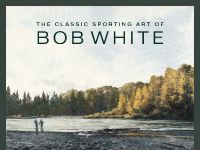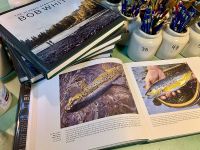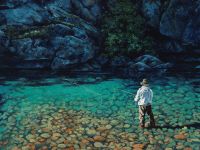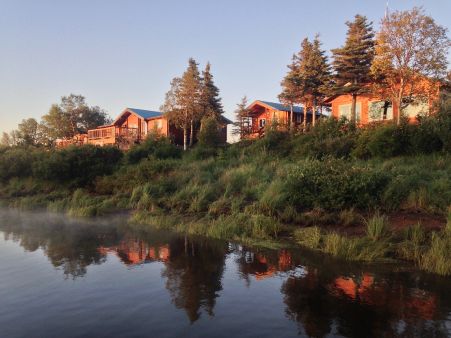If you had asked me, when I was my son’s age, what I wanted to be doing when I was 62 years old, I would have laughed at you. First, because I’d never be that old. Then, I would have described to you, more or less, exactly what I’m doing right now; sitting in my studio, writing about a book of my artwork.
It’s a long and winding road that brings me to this place, and I’ve traveled it in good company. I’ve been encouraged, supported, and mentored at every bend by an extraordinary group of people, many of them the fishermen and women I’ve guided over the past 35 years, my brother-guides, and some other artists; Eldridge Hardie comes to mind.This book, The Classic Sporting Art of Bob White, contains a collection of some of my favorite paintings. Every painting records a distinctive memory, and while some paintings are certainly more successful than others, the success of my work generally has more to do with how well I know the subject matter, and how deeply I feel about it, than anything I do with my brushes or colors.
For me, a painting is successful when it evokes sensory responses beyond the visual. I judge a painting to be good when in viewing it, I hear the river glide past, tumbling over the rocks that define its course. When I can feel the warmth of a low autumnal sun on my back. A good painting allows me taste the wind, feel the perfect balance of a fine shotgun in my hands, or listen to the quiet sound of falling snow. This only happens when I listen to what the painting has to say. My job as an artist is to listen, and in doing so, give my work a voice so it can speak to others.
I hope that this book will speak to you, about days on the water and in the field.
The Classic Sporting Art of Bob White
Publication - October of 2020 - Stackpole Books
- 10 x 12 inches
- 280 pages
- 246 annotated images
- Selected essays with illustrations
- Instructional side-bars
- Introductions by both John Gierach and Donnall Thomas
- Foreword by Tom Rosenbauer
The book can be purchased at most on-line book vendors, or
signed copies can be purchased on our website.
https://www.bobwhitestudio.com/shop/other-cool-stuff/the-bookshelf/fishing-books/the-classic-sporting-art-of-bob-white/?fbclid=IwAR0U_S3x_FTNVCt-HrcLm4RUgzyZEeifBZIsrMMM2jqJuUZCWz64xnHq8Mc
Options:
- Signed Copies
- Signed, limited edition (of 300) copies with an original pencil drawing on the title page.
Here’s an excerpt from the book… I hope you’ll enjoy it!
“In The Canyon” - 30 x 24 inches - oil on canvas
As a young fishing guide in Argentina, I fell in love with a stretch of the Malleo River we called, “The Canyon”. Back then few people fished it, perhaps because the ominous name insinuates steep rocky banks, deep pools, and dangerous crossings. To be sure, the river tumbles through a three-mile stretch of steep canyon walls, but it meanders between the towering volcanic rock, and rarely “cliffs-out”. Where it does it’s easily fished from the opposite side.
I think what kept most people away was the commitment it took to fish it. There was no access other than at the beginning and the end; once you started, the only thing to do was to finish it.
One of the first things I did when I picked up my new fishermen at the airport near San Martin De Los Andes, was to size them up as candidates to fish the canyon. Some of my fishermen could, and many others couldn’t. Those who could manage the all-day walk always got at least one day on my favorite water.
Gradually, as the season wound down, the fishing in the canyon slowed. When I explained this to my Argentine friend, Beto, with whom I often guided, he proposed a very interesting idea.
“You always walk it from the top to the bottom.” he said. “Perhaps the fish get used to seeing your flies about the same time every day. Next time, maybe you should start at the bottom and fish it upstream to the top.”
I followed my friend’s advice, and it fished wonderfully!







